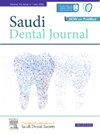Oral surgery considerations in patients at high-risk of complications related to drug intake: A systematic review
IF 2.3
Q3 DENTISTRY, ORAL SURGERY & MEDICINE
引用次数: 0
Abstract
Purpose
This study aims to identify and comprehend the management of the most frequent complications in oral surgery that arise from the consumption of multiple drugs.
Materials and Methods
A comprehensive review of 23 articles was conducted, focusing on the complications that arise from the consumption of drugs in patients undergoing oral surgery treatment, in addition to the strategies for prevention and treatment.
Results
All the reviewed articles offered insightful knowledge into preventing complications through well-defined protocols that encompass both pre- and post-operative measures. These measures include local interventions such as periodontal treatments, dental prophylaxis, and hygiene instructions, as well as systemic approaches like antibiotic prophylaxis and post-surgical antibiotic coverage. Additionally, specific measures like monitoring prothrombin time with the International Normalized Ratio in patients with coagulation disorders, and implementing hemostatic techniques, were also discussed.
Conclusion
The most prevalent complications in oral surgery are hemorrhage in anticoagulated patients, infections in immunosuppressed patients, and osteonecrosis in patients who take antiresorptive drugs. Edema, pain, and inflammation are also common post-operative concerns. When managing high-risk patients pharmacologically, it is crucial to provide effective antibiotic coverage both pre- and post-procedure and to utilize minimally invasive dental procedures with local hemostatic measures.
与药物摄入相关的高危并发症患者的口腔手术注意事项:一项系统综述
目的本研究旨在了解口腔手术中因使用多种药物而引起的最常见并发症的处理方法。材料与方法对23篇文献进行综合综述,重点分析口腔外科患者用药引起的并发症及防治策略。结果所有回顾的文章都提供了有见地的知识,通过定义明确的方案,包括术前和术后措施,以预防并发症。这些措施包括牙周治疗、牙齿预防和卫生指导等地方干预措施,以及抗生素预防和手术后抗生素覆盖等系统方法。此外,还讨论了凝血障碍患者采用国际标准化比值监测凝血酶原时间、实施止血技术等具体措施。结论口腔外科手术中最常见的并发症是抗凝患者出血、免疫抑制患者感染和服用抗吸收药物患者骨坏死。水肿、疼痛和炎症也是术后常见的问题。在对高危患者进行药理学管理时,至关重要的是在术前和术后提供有效的抗生素覆盖,并利用微创牙科手术和局部止血措施。
本文章由计算机程序翻译,如有差异,请以英文原文为准。
求助全文
约1分钟内获得全文
求助全文
来源期刊

Saudi Dental Journal
DENTISTRY, ORAL SURGERY & MEDICINE-
CiteScore
3.60
自引率
0.00%
发文量
86
审稿时长
22 weeks
期刊介绍:
Saudi Dental Journal is an English language, peer-reviewed scholarly publication in the area of dentistry. Saudi Dental Journal publishes original research and reviews on, but not limited to: • dental disease • clinical trials • dental equipment • new and experimental techniques • epidemiology and oral health • restorative dentistry • periodontology • endodontology • prosthodontics • paediatric dentistry • orthodontics and dental education Saudi Dental Journal is the official publication of the Saudi Dental Society and is published by King Saud University in collaboration with Elsevier and is edited by an international group of eminent researchers.
 求助内容:
求助内容: 应助结果提醒方式:
应助结果提醒方式:


